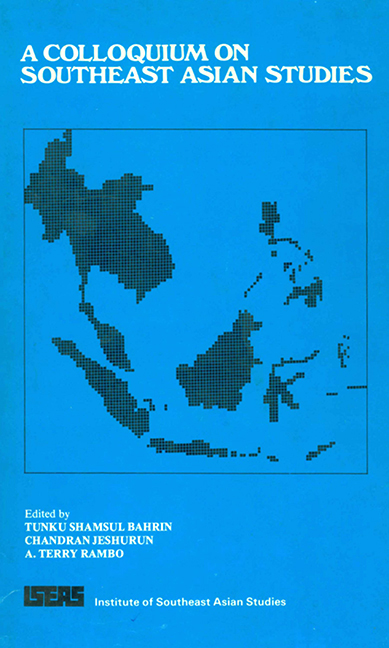Book contents
- Frontmatter
- Contents
- Foreword
- Preface
- Acknowledgements
- Introduction
- Contributors
- PART I TEACHING AND RESEARCH
- THE CONCEPTUAL THEORIES
- THE EXTRAREGIONAL EXPERIENCE
- 4 Southeast Asian Studies in Australia
- 5 Southeast Asian Studies in France
- 6 Southeast Asian Studies in the United Kingdom
- 7 Southeast Asian Studies in the United States: Towards an Intellectual History
- THE REGIONAL PERSPECTIVE
- THE PROBLEMS OF TEACHING AND RESEARCH
- PART II ENVIRONMENT AND DEVELOPMENT
6 - Southeast Asian Studies in the United Kingdom
from THE EXTRAREGIONAL EXPERIENCE
Published online by Cambridge University Press: 21 October 2015
- Frontmatter
- Contents
- Foreword
- Preface
- Acknowledgements
- Introduction
- Contributors
- PART I TEACHING AND RESEARCH
- THE CONCEPTUAL THEORIES
- THE EXTRAREGIONAL EXPERIENCE
- 4 Southeast Asian Studies in Australia
- 5 Southeast Asian Studies in France
- 6 Southeast Asian Studies in the United Kingdom
- 7 Southeast Asian Studies in the United States: Towards an Intellectual History
- THE REGIONAL PERSPECTIVE
- THE PROBLEMS OF TEACHING AND RESEARCH
- PART II ENVIRONMENT AND DEVELOPMENT
Summary
The form in which Southeast Asian Studies is taught in the United Kingdom varies widely between different universities and is determined principally by the relative resources of the institution involved. The Association of Southeast Asian Studies in the United Kingdom has approximately eighty members at the present time, drawn overwhelmingly from university lecturing staff. In many British universities, for example, Aberdeen, Bath, Bristol, Dundee, Durham, Lancaster and Leicester, where only one or two lecturers specialize in Southeast Asia, the area must inevitably be treated within the disciplinary field of the lecturer concerned. By tradition and in terms of staff numbers and library resources, London University is preeminent in Southeast Asian Studies. The School of Oriental and African Studies has between thirty and thirty-five lecturing staff who might be regarded as specialists in some aspect of Southeast Asian Studies, and another half-a-dozen lecturers with area interests are located in nearby colleges, such as Royal Holloway College, the London School of Economics, Goldsmith College and the Institute of Commonwealth Studies. The University of Hull, which began to develop a Centre for Southeast Asian Studies as a consequence of the Hayter Report of 1961, has nine lecturers housed in the Centre, while two other lecturers, in the departments of Geography and Theology respectively, have a direct teaching and research interest in the region. The University of Kent at Canterbury, which began developing its own Southeast Asian Studies programme in 1969, now has six lecturers who are specialists in the area.
In the three universities which have relatively complicated Southeast Asian Studies programmes, London, Hull and Kent, there are certain obvious differences of emphasis and some similarities. The largest department concerned with Southeast Asia in the School of Oriental and African Studies (SOAS) is the Department of the Languages and Cultures of Southeast Asia and the Islands, which has sixteen lecturing staff.
- Type
- Chapter
- Information
- A Colloquium on Southeast Asian Studies , pp. 58 - 71Publisher: ISEAS–Yusof Ishak InstitutePrint publication year: 1981



